In the previous episode we left the heroine of our story Curiosity, heading north inside the MSL spacecraft making its way through the Martian atmosphere and using friction to slow down.
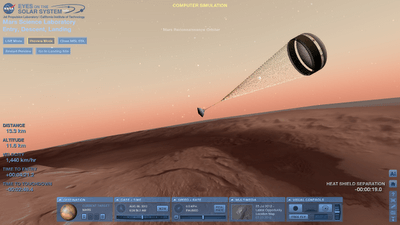
Please note: this entry continues the previous one "Diving into the atmosphere of Mars".
The article was first published on the blog "critical mass"
In the previous episode we left the heroine of our story Curiosity, heading north inside the MSL spacecraft making its way through the Martian atmosphere and using friction to slow down.
In the first contact with the atmosphere, MSL was at an altitude of 125 kilometers and at a speed of 6 kilometers per second.
Now, after the thin atmosphere of Mars has slowed the lander down to 2 times the speed of sound (in the middle of the ocean), MSL remains at a height of about 11 kilometers above the ground, and at a speed of about 450 meters per second. The atmosphere no longer produces enough friction for an object of its dimensions, and for this purpose it must be slowed down by another method; When MSL reaches this speed, a huge parachute, with a diameter of 16 meters, will be deployed, whose job is to slow down its horizontal speed.
The parachute is designed to reduce the velocity energy of the lander by 95% in just 50 to 90 seconds!
24 seconds after the parachute retires, MSL is expected to be at a height of 8 kilometers, and at a speed of 125 meters per second. The parachute still slows down the speed, but not at a fast enough rate, and in addition there is still a horizontal speed that will not allow an accurate landing. Therefore, a more controlled descent is needed, which will be carried out using rockets.
The Curiosity rover is folded inside MSL with the descent stage attached to its back, a propulsion system with eight powerful rocket engines (a sort of jetpack). When a speed of 125 meters per second (subsonic speed) is reached, the heat shield is thrown and the Curiosity rover with the descent phase is exposed to the Martian air.
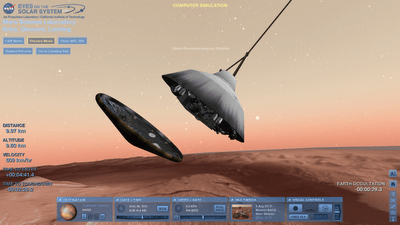
Uncovering the rover allows two things, starting to photograph the ground, and measuring the height using radar.
The radar is installed on the descent stage, and its purpose is to accurately measure the height at which the vehicle is located. After releasing the heat shield, the radar will wait 5 seconds before starting to work, so that the shield has enough time to move away and not confuse the distance reading.
In the front left corner of the rover itself there is a small camera called MARDI (short for Mars Descent Imager), which is pointed downwards, and its entire function is to record the landing phase. The photographs will be in full color and high definition and will allow the rover's operating team to receive information about the area around the landing point, in a much better quality than can be obtained from photographs from space. The landing tape will not be used for navigation during the descent and will not be broadcast in real time due to bandwidth limitations. Therefore, to watch the landing film we probably have to wait several days, but it's going to be worth the wait!
MARDI will start shooting immediately after releasing the heat shield, and will even use white surfaces that are glued to its inner side for White Balance (if you don't know the concept, ask photography enthusiasts).
About 85 after the release of the heat shield, the lander, still hanging on the parachute, is expected to be at a height of one and a half to two kilometers (according to the radar measurements). The ground will rush towards it at a speed of about 100 meters per second. Under these conditions, the descent phase is activated: the eight rocket engines, directed downwards around the rover, begin to operate at 1% of their full power - and the descent phase detaches from the shell that covered it and the parachute, and falls down.
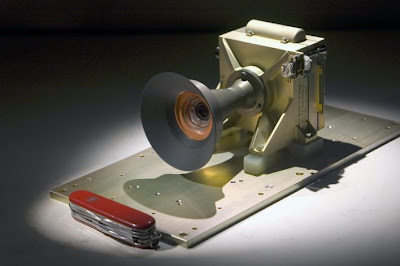
The free fall is designed to get away from the canopy and the parachute, before increasing the thrust of the engines, and it lasts only about one second.
The engines increase their power, first to restrain spin speeds, then at full power, to slow down the rate of fall while completely canceling the horizontal movement.
Curiosity and the descent phase
The eight engines will reduce the rate of descent to about 20 meters per second. This rate will continue until the radar measures a height of 50 meters from the ground. Then they will increase their power and slow down the rate of descent to 75 centimeters per second. Try to imagine this pace, it is very slow.
At 21 meters, the descent stage engines have already burned about 400 kilograms of fuel, so if the engines continue to operate at this power, they will begin to pull the rover upwards (same thrust on less mass gives greater acceleration). Therefore, their power is reduced to maintain the slow rate of descent, which should be kept constant until contact with the ground. At some point the engines will operate with weak and inefficient power, so simply turn off four of them.
The eight engines are in the four corners of the rover, a pair in each corner, with one engine of each pair facing down, and the other as well, but tilted slightly outwards. The four tilted engines are the ones that continue to operate, and this is to prevent the jet emitted from them from hitting the rover during the sky crane stage (original translation to Sky Crane).
2.5 seconds after the shutdown of the four engines (the other four will operate at approximately half power), pyrotechnic explosives will be activated that will separate the rover from the descent stage. The rover will actually begin to fall down, attached to the landing stage by three harnesses. The harnesses, made of nylon cords, grab the rover at three points around its center of gravity, and unfurl from a coil at the bottom of the descent stage (below its center of gravity, so it stays balanced).
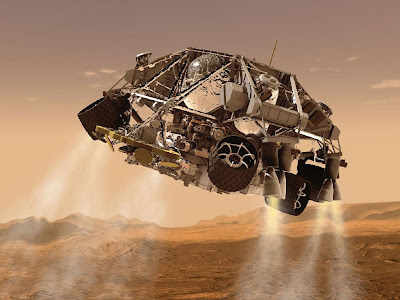
The coil is also a sophisticated mechanism, which releases the three harnesses together under the control of an electromechanical brake that controls its rotation speed and thus the rover's descent speed.
In addition, there is also an umbilical cable (umbilical, an electrical interface between devices for transferring power and data) connecting Curiosity and the landing stage, because the rover's computer operates both.
The harnesses will deploy to their full length, which is 7.5 meters, and the landing stage will continue to lower Curiosity at the gentle speed of 75 centimeters per second until contact with the ground. A few seconds before contact, the rover's wheel suspensions will be released, and will stretch downward, ready to absorb the impact on the ground like an airplane's undercarriage.
After landing, the ground will support the rover's weight, and the descent phase will feel the relief of the force exerted on it.
He will wait a second to make sure his measurements are true and constant, and to adjust the thrust of the engines to support his weight only. After this second, electric guillotine mechanisms are activated that cut the nylon harnesses at the connection points on Curiosity's back. The harnesses roll back into their coil in a second using a spring. At the same time, Curiosity commands the descent stage and cuts the umbilical cord. This is the signal for the descent phase to climb and move away from the place so as not to endanger the rover. It will crash at least 150 meters away.
And what now?
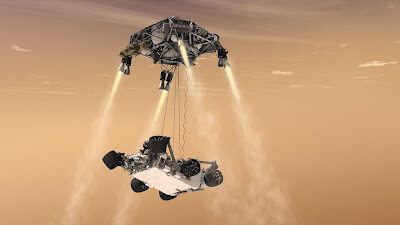
Almost nothing.
Curiosity will transmit continuously using its UHF transmitter so that the Odyssey orbiter can transmit the data on the mission status to Earth, but initially no more than that before instructions from the control center on Earth arrive, and these will not arrive until the morning of the next Edirne day.
About the activation of the rover, the retirement of the equipment and the start of Curiosity's work, in the following records.
for further reading:
First entry in the Curiosity series: How hard is it to land on Mars?
Second entry in the Curiosity series: Dive into the atmosphere of Mars
Press information about the MSL program (PDF file)
Summaries from the Planetary Society blog
GET CURIOUS
_____________________________________
Photo credit: NASA
Simulation: NASA and JPL's Eyes on the Solar System website

15 תגובות
Oh… and you got shrapnel in your face?
Yes, they didn't take into account the low atmospheric pressure there, so the tires overinflated and exploded...
Woe. What about all of them? According to the laughter of the scientists at NASA, it seems that they have a spare..
It turns out that there is no air in the wheels of the rover...
N.C
Where is Hayatarbak??? I've been looking for this lucky thing for hours...
I've already lost my suit... :):::::
It turns out that the amazing technology won, but also quite a bit of luck played here.
Clalllalllal Honestidoddoddoddaddod !!!!!!!!!!!!!!!!!!!!!!!!!!!!!!!!!!!!!!!!!
The rover landed successfully.
The website I mentioned does not broadcast photos for some reason (so far only a previous press party).
The photographs will be transmitted by a satellite orbiting Mars, the name of the satellite Odysseus (?). According to yesterday's press party on the website I mentioned - there will be such a transfer experiment immediately after landing and about an hour later (when the satellite completes its orbit around Mars).
Press party and real-time broadcasts (probably via Odissi) here
http://mashable.com/2012/08/05/mars-curiosity-landing/
NASA live webcast has started now.
The broadcast is here
http://mashable.com/2012/08/05/mars-curiosity-landing/
N.C
"It is very difficult to say this, but now about 10 hours before the landing I predict that the landing will not be successful."
Where are you watching this from? And is it possible too? Do you need to bring a spacesuit with you?
I read about the whole process carefully. There are dozens of possibilities for failure, and you need a lot of luck
May this matter succeed.
It is very difficult to say this, but now about 10 hours before the landing I predict that the landing will not be successful.
Of course, I wish I was killed.
Tomorrow the big story. Hope they broadcast the landing procedure online.
Too many steps until landing.
Hope everything goes as planned...
Successfully
Good luck to Curiosity! Write to us about the landing later..
Spectacular visualization of what is described here, you can start from minute 1:40
http://www.youtube.com/watch?v=P4boyXQuUIw